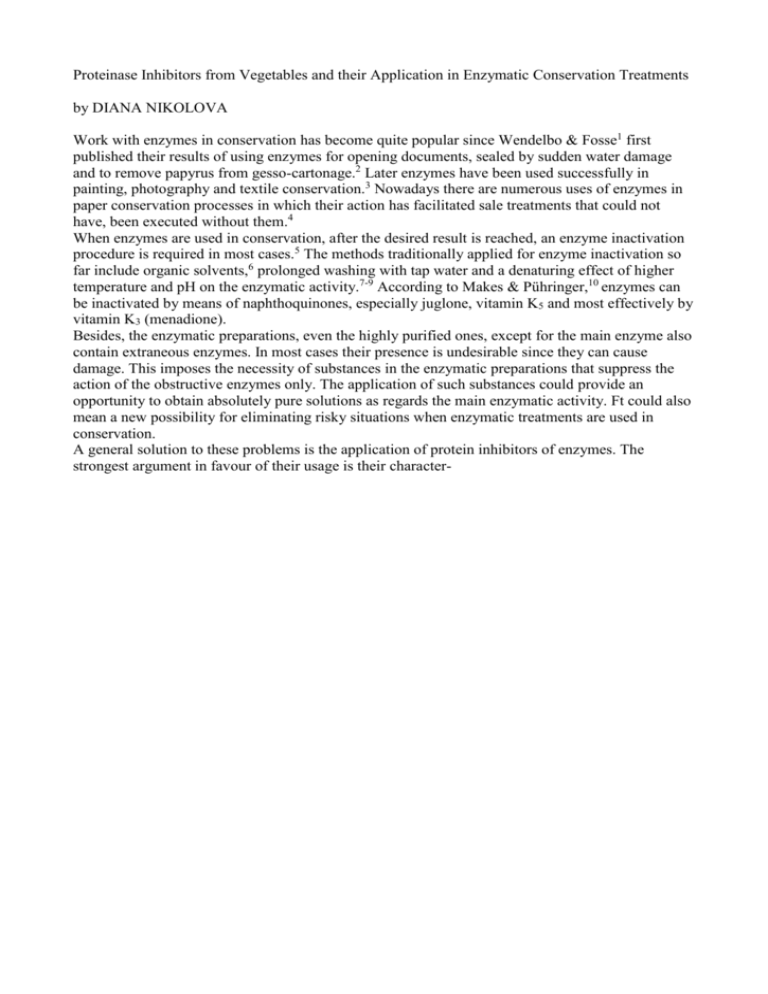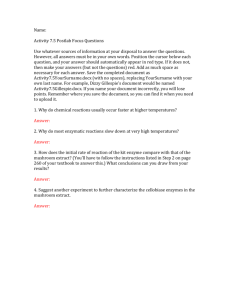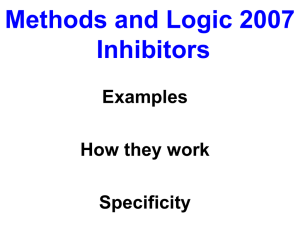Proteinase Inhibitors from Vegetables and their Application in
advertisement

Proteinase Inhibitors from Vegetables and their Application in Enzymatic Conservation Treatments
by DIANA NIKOLOVA
Work with enzymes in conservation has become quite popular since Wendelbo & Fosse1 first
published their results of using enzymes for opening documents, sealed by sudden water damage
and to remove papyrus from gesso-cartonage.2 Later enzymes have been used successfully in
painting, photography and textile conservation.3 Nowadays there are numerous uses of enzymes in
paper conservation processes in which their action has facilitated sale treatments that could not
have, been executed without them.4
When enzymes are used in conservation, after the desired result is reached, an enzyme inactivation
procedure is required in most cases.5 The methods traditionally applied for enzyme inactivation so
far include organic solvents,6 prolonged washing with tap water and a denaturing effect of higher
temperature and pH on the enzymatic activity.7-9 According to Makes & Pühringer,10 enzymes can
be inactivated by means of naphthoquinones, especially juglone, vitamin K5 and most effectively by
vitamin K3 (menadione).
Besides, the enzymatic preparations, even the highly purified ones, except for the main enzyme also
contain extraneous enzymes. In most cases their presence is undesirable since they can cause
damage. This imposes the necessity of substances in the enzymatic preparations that suppress the
action of the obstructive enzymes only. The application of such substances could provide an
opportunity to obtain absolutely pure solutions as regards the main enzymatic activity. Ft could also
mean a new possibility for eliminating risky situations when enzymatic treatments are used in
conservation.
A general solution to these problems is the application of protein inhibitors of enzymes. The
strongest argument in favour of their usage is their character-
Istics:11 exceptional specificity of the activity of protein inhibitors. The enzymes arc inactivated
very quickly - right after the inhibitor is added into the enzymatic solution. Protein inhibitors are
easily dissolved in water, thus forming colourless solutions. These substances have a high degree of
stability regarding denaturing agents. Every .single protein inhibitor reacts only to the corresponding enzyme and is not chemically active to the material content of the objects of conservation. They
are not dangerous to the health of the restorer.
It has long been known that animals and plants produce protein inhibitors. In Japan microorganisms
have been studied for enzyme inhibitors since 1965 and world-wide beginning more recently12.The
interest in protein inhibitors is connected with their biological action and the possibilities for their
application in different fields. Their isolation, purification, examination and application are one of
the modern tendencies in contemporary biochemistry. Nevertheless, nowadays companies for
biochemicals offer just a few protein inhibitors of enzymes for research purposes. Thus, the
application of protein inhibitors in enzymatic processes in conservation begins with the search for
suitable sources and schemes for their isolation. The percentage of protein inhibitors is greater in
vegetable sources than in animal or microbial ones. Besides, the vegetable sources are easily
accessible and inexpensive. That is why they are most suitable as a source of protein inhibitors of
enzymes for conservation treatments.
The purposes of the study as a whole were:
• to find protein inhibitors of proteases from a vegetable source typical of Bulgarian flora;
• to find a vegetable source that is rich in protein inhibitors;
• to find an inhibitor (or inhibitors) of Bulgarian preparations of proteolytic enzymes or trypsin that
is generally available;
• to elaborate a scheme for isolation and purification that is easy to apply in conservation
laboratories; and
• to demonstrate the use of the protein inhibitors in enzymatic conservation treatments.
MATERIAL AND METHODS
Seeds of Kohlrabi (Brassica napus var. rapifera} were purchased from the company Sortovy
Semena (Sofia, Bulgaria). Pancreatic trypsin Novo (6 Anson units/g) was a product of Novo
Nordisk (Bagsværd, Denmark). Trypsin purified from bovine pancrease was a product of Fluka AG
(Buchs, Switzerland), cat. no. 93612. Pure α-chymotrypsin from bovine pancrease was supplied by
Sigma Chemical Company (St. Louis, MO, LISA), cat. no. 7762. Preparations
of α-amylase from Bacillus subtilis, α -amylase from Aspergillus oryzae and alkaline proteinase B72 were products of Chimcompany (Botevgrad, Bulgaria). Sephadex G-25 was obtained from
Pharmacia (Uppsala, Sweden).
Two sons of papers were used to study the salt content of the solutions for washing away the
coloured components in the extract out of the treated object - A from 1990 and 15 from 1960. 'She
brightness of the paper samples was measured on a Specol equipped with relief lion meter (Carl
Zeiss, Jena, Germany). A scanning electron microscope Philips, model 515 (the Netherlands) was
used.
Two photographs with purely gelatine emulsion were taken for the investigation. They were dated
from 1930 and I960. Both photographs were private and without historical value. The protein
content of the extract after the purification procedures was determined on the basis of amino acid
composing . It was calculated by using a BIOTRONIK automatic analyser mode! 6001 (Germany)
after 24 h of hydrolysis in 6 M HCl in evacuated sealed tubes at 110°C.
Method of isolation and purification of the protein inhibitors from kohlrabi seeds
One hundred grains of kohlrabi seeds was ground and extracted for 90 min at room temperature
with 500 ml of distilled water. The extract was filtered through gauze or similar cotton textile. The
sediment was re-extracted with 250 ml of distilled water under the same conditions. The two
filtrates were combined and the pH was adjusted to 5.00. After one night at ±4CC, the fats and
precipitated proteins were removed by centrifugation at 4500 rpm for 15 min. The pH of the
supernatant was adjusted to 7.4 and the precipitated pH-labile proteins were discarded by
centrifugation. The supernatant was heated gradually to 70°C, kept for 5 min at this temperature and
cooled to room temperature. The mixture was centrifuged and the sediment containing thermolabile proteins was discarded. The supernatant obtained was the purified extract applied in
conservation. The extract can be stored frozen. If it is possible, the extract can be lyophilized. The
obtained powder is stored at 4°C.
As the extract is yellow, it could be treated with activated carbon (shaped rods, ǿ1.2 mm - VKB
Jenapharm — Laborchemie, Germany) for eliminating the dyestuffs. The carbon was used in the
proportion 15 g per 100 ml of extract for 30 min at room temperature. The mixture was filtered
through a Büchner funnel and a blue tape filter.
Determination of inhibitory activity
The inhibitory activity was tested according to the cascinolytic method of Ogiso et al.13 with a
slight modification.
The following procedure was applied: to 0.25 ml of enzyme solution in 0.1 M phosphate buffer, pH
7.4. was added 0.25 ml of inhibitory extract into both test and control tube. The mixtures were
incubated for 5 min at 36° C. Then 2.5 ml of 1% casein solution. pH 7.4 was added to the test tube
and 2.5 ml of 0.5 M HCLO4 to the control tube. After JO min the enzymatic reaction in the test tube
was stopped with 2.5 mi of 0.5 M HC1O4. Then 2.5 ml of 1% casein solution was pipetted into the
control tube. After filtration through a blue tape filter, the absorption of the filtrates was measured
at 280 nm. The difference between the absorption of the test tube and the control tube as a
percentage from the lull enzymatic activity was the percentage of the remaining enzymatic activity.
Full enzymatic activity was established in the same way but instead of 0.25 ml of inhibitory extract
a buffer solution was dropped into the tubes. It was accepted as 100%.
The difference between the full enzymatic activity and the remaining enzymatic activity was the
inhibitory activity of the extract. One unit of inhibitory activity is 1% suppression of the enzymatic
activity. This unit was accepted as a conditional one because the present study was not connected
with a standardized inhibitory product. The remaining activity of enzymes in the presence of
inhibitors was presented not only as a percentage but also as absorbance at 280 nm. A recording
spectrophotometer (Shimadzu model 3000, Japan) was used to measure the absorption.
RESULTS AND DISCUSSION
Testing different vegetable seeds established a very high inhibitory activity of the extract from
Kohlrabi seeds towards trypsin, alkaline proteinase B-72 and proteinase in α-amylase preparations
from Bacillus subtilis and Aspergillus oryzae and no activity to chymotrypsin.
The scheme for isolation and purification included changes of pH and heating of the extract for
removing pH- and thermo-labile proteins. These procedures were possible because the protein
inhibitors of enzymes are very resistant to pH changes and high temperatures as well as to other
denaturing agents.11 That is why the scheme without the stage of discoloration could be also used as
a test in screening vegetable sources for protein inhibitors of enzymes.
A summary of the purification procedure of the fully extracted inhibitors is presented in Table 1.
Gel filtration was a step of purification for obtaining pure protein inhibitor;;. The elution profiles
(Fig. 1) show two protein peaks - A and B. They have inhibitory activity towards the abovementioned enzymes. The first peak contains a typical trypsin inhibitor.14 The data In Table 1 were
used to calculate that the content of the inhibitors in peak A and peak B was 7.6% and 2.6%
respectively or 10.2% in total, which was a great quantity of protein inhibitors. The explanation was
that these proteins belong to the Brassica napus family of storage proteins.14 At seed maturity,
napins comprise approximately 20% of total seed protein.15
The third peak (Fig. 1} corresponded to the dyestuffs in the extract. The elution profiles before
(curve 1} and after (curve 2) the treatment with activate carbon gave information on the effect of
discoloration. Carbon was used because the dyestuffs could not be extracted satisfactorily with
volatile organic solvents, as is often done in such cases. The treatment with activated carbon is
connected with considerable losses of inhibitors and inhibitory activity about 35% (Table 1). But it
was the easiest way to achieve discoloration. Of course, there are possibilities for absolute
discoloration of the extract. They are ultrafiltration or gel chromatography. But they require the
specific equipment of biochemical laboratories and biochemical manufacturing.
The final extract, discoloured by means of activated carbon, had a very
Table 1. Purification of protein inhibitors of proteinases from kohlrabi seeds
Fig. 1. Gel filtration of extract of protein inhibitors from Kohlrabi seeds
A column of Sephadex G-25 (1.5 x 80 cm) was used, equilibrated and eluted with 0.05 M
ammonium bicarbonate buffer, pH 7.4, at a flow rate of 12 ml/h. Elution profile (1) before and (2)
after treatment of the extract with activated carbon.
pale yellow colour that was already suitable for application in conservation practice.
There was another possibility for the elimination of the dyestuffs in the objects after their treatment
with the inhibitor extract. There were 2 coloured components in the extract. They both had a high
degree of polarity and negative charges.16 Besides, the colouring substances that remained partly on
Sephadex G-25 in the process of gel chromatography were removed by buffer with high ionic
strength. Usually this is achieved by means of a higher concentration of NaCl. On this basis it was
established that, after treatment of paper samples with a coloured extract, washing of the samples
with a solution of high NaCl content (I teaspoonful in 500 ml of water's and rinsing After that with
water led to the removal of the coloured components (Table 2).
The speed of action is one of the most important characteristics of the protein inhibitors. It proves
thorn as suitable for conservation purposes. The protein inhibitors act on the enzymes immediately
after they are added to the enzymatic solution. This was demonstrated through a suitable scheme for
Table 2. Influence of the sail confirm of the solutions on the washing away of the
coloured components in the extract out of the treated objects
Control: paper soaked for 30 min in water; treatment 1: soaking in water for 30 min, then for 10 min
in the extract, washing for approximately 10 min with tap water; treatment 2: soaking in : water for
30 min, extract from kohlrabi seeds for 10 min, then washing, soaking for 5 min in a solution of
NaCl2, washing with water.
spectrophotometric determination of the enzymatic and inhibitory activity (Table 3). The addition
of the inhibitory extract into the mixture of the enzyme trypsin (Fluka, 5 mg in 100 ml of 0.1 M
phosphate buffer, pH 7.4) and the substrate (1% casein, pH 7.4) after 10 min reaction gave the same
effect as the stopping the enzymatic reaction after 10 min by means of 0.5 M HClO4. Visually, this
was demonstrated by the following experiment.
Four samples were taken from a photograph with purely gelatine emulsion. On each of the first 2
samples were dropped 60 μl of trypsin solution in a phosphate buffer at pH 7.4 (5 mg of trypsin
(Fluka) in 100 ml). On the other 2 samples were dropped 60 μl of trypsin solution in an extract from
kohlrabi seeds, which was prepared as a buffer at pH 7.4. The solutions acted for 20 and 45 min
respectively at room temperature. At the end of the periods of time the samples were washed with
cold water, then left for 2 h in a refrigerator and finally dried with a hair-dryer. The changes in the
morphology of the test samples were traced by means of a scanning electron microscope. Fig. 2-5
give the results. They confirm the effective action of the protein inhibitors.
The next stage in the investigation was to prove the effectiveness of the extract towards trypsin
Novo. Solutions of trypsin Novo were prepared in
Table 3. Speed of the inhibitory action of the enzymes
Fig. 2. Action of a trypsin solution (5 mg/100ml) in a buffer on the gelatine layer of a photograph
after 20 min (magnification x 50)
different concentrations ranging from 0.01% to 0.1%. After 10 min of enzymatic reaction, the
absorption at 280 nm was measured. It corresponded to the remaining proteolytic activity. The
extract can suppress the activity of trypsin Novo up to 0.04% solution of the enzyme in the extract
(Fig. 6).
It is known that the pancreatic trypsin Novo contains α-chymotrypsin as an extraneous cnx.ymc."
Tlic ininbitors from kohlrabi seeds are not effective towards chymotrypsin, and its protcolytic
activity can be detected after an enzymatic reaction longer than 10 min.
The action of the a-chymotrypsin in 0.02% solution of trypsin Novo in the extract was detected
after 20 min (Fig. 7, curve 1). In comparison with the full activity of 0.02% trypsin Novo in a buffer
(Fig. 7, curve 2), the α- chymotryptic one was about 2%. But for conservation treatments, this
minimal proteolytic activity could be dangerous in the course of time.
The action of the α-chymotrypsin could be suppressed again by means of protein inhibitors from
vegetables. It is known from the specialized literature that one such source is potatoes.17,18 The
scheme, described in the present study, was applied again. But the first extraction was with 150 nil
and the second one with 50 ml of distilled water for 50 g of peeled and grated potatoes. No
Fig. 3. Action of a trypsin solution (5 mg/100ml) in a buffer on the gelatine layer of a photograph
after 20 min (magnification x 50)
difficulties arose with the colour in this case. The solution of pure α-chymotrypsin (Sigma) proved
that the extract of potatoes had a good inhibitory activity. After that, a 0.02% solution of trypsin
Novo in an extract of kohlrabi seeds was mixed with an extract of potatoes in proportions from 5:1
to 5:5. The remaining proteolytic activity of the above mixtures was determined after 60 min. It was
established that the first proportion was sufficient to stop the entire activity of the extraneous
chymotrypsin in the pancreatic trypsin Novo. Based on the conditions of the reaction, it was
determined that every 6 ml from the mixture of the extracts of kohlrabi seeds and potatoes in a ratio
of 5: 1 suppressed the action of 5 ml of 0.02% (or 2.5 ml of 0.04%) solution of trypsin Novo in a
buffer. This conclusion is of importance for the practical conservation work.
In accordance with the experiments, 4 pairs of samples were taken from a photograph with a pure
gelatine emulsion (fig. 8). The samples from the upper line were soaked in a 0.02% solution of
trypsin Novo in a 0.1 M phosphate buffer, pH 7.4 at 35 °C for 20, 30, 40 and 50 min for samples 1,
2, 3 and 4. The corresponding samples from the bottom line were soaked under the same conditions
in a 0.02% solution of trypsin Novo in a mixture of
Fig. 4. Action of a trypsin solution (5 mg/100 ml} in an extract from kohlrabi seeds on the gelatine
layer of a photograph after 20 min {magnification x 50)
kohlrabi seed and potato extracts (5:1). The mixture of the extracts was prepared as a buffer. For
this purpose were added the quantities of substances necessary for a 0.1 M phosphate buffer. After
they dissolved the pH was adjusted to 7.4 by means of a pH meter. After 50 min (sample 4. upper
line) the pure enzyme solution almost destroyed the gelatine layer (Fig. 9). At the same time, the
effective inactivation of trypsin Novo by the protein inhibitors preserved the gelatine layer from
damage (bottom line samples).
The following example could be given for the practical application of the extracts of protein
inhibitors:
Problem: separation of 5 leaves of a book printed on glue-sized paper and sealed by water damage.
Method of separation: by means of a 0.02% solution of trypsin Novo (6 Anson units/g).
Procedure
1. Preparation of the solution for stopping the enzymatic reaction after the desired conservation
effect is achieved:
Fig. 5. Action of a trypsin solution (5 mg/100 ml) in an extract from kohlrabi seeds on the gelatine
layer of a photograph after 45 min (magnification * 50)
• Obtain an extract of kohlrabi seeds according to the scheme.
• Obtain an extract of potatoes according to the scheme.
• Mix the extract from kohlrabi seeds with the extract of potatoes in a ratio of 5 : 1 so that the
volume of the mixture will be sufficient to cover the 5 leaves.
• Prepare the mixture of the extracts as a 0.1 M phosphate buffer at pH 7.4.
2. Preparation of the enzymatic solutions:
Take 13.8 g of Na2HPO4-2H2O and 8.8 g NaCl and add them to 1000 ml of distilled water. Adjust
the pH to 7.4 with 0.5 M NaOH by means of a pH meter. Prepare a 0.02% solution of trypsin Novo
with this buffer.
3. Treatment of the leaves:
• Soak the leaves into the 0.02% buffer solution of trypsin Novo.
• Take the leaves after their separation upon the enzymatic action and put them into another vessel.
Fig. 5. Inhibition of solutions of trypsin Novo in different concentrations in an extract from kohlrabi
seeds
Fig. 7. Activities of trypsin and chymotrypsin in a 0.02% solution of trypsin Novo. Curve 1: in
extract pH 7.4; curve 2: in phosphate buffer, pH 7.4
Fig. 8. Samples from a photograph before enzymatic treatment
Fig. 9. Samples from Fig. 8 after enzymatic treatment in the absence (upper line) and in the
presence (bottom line) of protein inhibitors
• Pour the prepared solution of the protein inhibitors over the leaves and
let it stay for some minutes, shaking the vessel.
• Discard the mixture of the inhibitors and put the leaves into NaCl
solution (1 teaspoonful for 500 ml of distilled water), again shaking the
vessel.
• Wash away the leaves with water and keep them for the next conservation treatments.
If you work with discoloured activated carbon extract from kohlrabi seeds, the extract should be
mixed with the potatoes extract in a ratio of 7.0: 1.
The next part of the study demonstrates how important it is to use an absolutely pure solution of
enzymes as well as obtaining them by means of protein inhibitors as regards the main activity of
technical enzymatic products. The necessity of such purity of the enzymatic solutions for
conservation purposes was substantiated by Preiss & Cook.19 The extraneous proteolytic activity in
a highly purified preparation of α-amylase from Aspergillus oryzae was arrested.
The proteolytic enzyme was in a very small quantity. It \vas detected by measuring the proteolytic
activity of a 0.1% solution of the α-amylase preparation after 10. 20, 30, 40: 50 and 60 min.
The next step was to prepare solutions of the α-amylase preparation in a buffered extract of kohlrabi
seeds, pH 7.4, in concentrations of 0.1%, 0.2%. 0.4%, 0.5%, 0.7% and 1.0%. Their proteolytic
activity was determined after 30 mm of reaction at 36 (J. The results proved that the extract could
suppress the proteolytic activity of the α-amylase preparation from 0 to 0.2% (Fie. 10). The aamylase product was used for backing removal of starch-pasted photograph. '! he test samples were
taken from a photograph from 1930 with a purely gelatine emulsion. The photograph was stuck \\ith
starch glue on cardboard. On the underside of the photograph over the cardboard was stuck, again
\viih starch glue, dark brown paper.
The sample on (he left side of Fig. ! 1 was soaked in a 0.2% solution of the α-amylase in an extract
of the inhibitors from kohlrabi seeds at 35 "C and pH 7.4. The extract was prepared as a 0.1 M
phosphate buffer. The concentration was higher because a treatment at pH 7.4 was chosen,
whereaeas the optimal oil of this α-amylase was 4.8. After 55 min, the photograph was separated
from the backing. The picture was preserved due to the effective inactivation of the proteinase
impurity by the inhibitors (Fig. 12, left). Thus, an absolutely pure solution of a-arnylasc was used.
The sample on the right side of Fig. 1 1 was treated with a 0.02% solution of the same preparation
but in 0.1 M phosphate buffer at 35°C and pH 7.4.
Fig. 10. Arrest of the extraneous proteolytic enzyme in an α-amylase preparation from Aspergillus
oryzae witth the inhibitors in an extract from kohliraby seeds
Fig. 11. Samples from a photograph before enzymatic treatment
After 55 min the same effect of separation was reached. But the picture was damaged because of the
destruction of the gelatine emulsion by the negligible quantities of proteinase in the α-amylase
preparation (Fig. 12. right').
CONCLUSION
The inhibitor extracted from kohlrabi seeds is an excellent method for arresting trypsin and some
other proteinases as well as for obtaining an absolutely pure solution with a-amylase activity from a
microbial product of a-amylase containing an obstructive proteolytic enzyme. It entirely suppresses
the action of pancreatic trypsin Novo in a mixture with the protein inhibitor of chymotrypsin in an
extract from potatoes. The .scheme for the isolation and the partial purification of protein inhibitors,
which is given, can be successfully applied as a test to find arid to obtain protein inhibitors from
vegetable sources. It is also easy to follow in a conservation laboratory. Protein inhibitors are very
effective to stop the enzymatic action after the desired conservation result is reached. There are
protein inhibitors of amylases and other enzymes as well. It is clear that they should be applied
similarly. Protein inhibitors are suitable for conservation purposes. Their application gives a
finished state to the enzy-
Fig. 12. Samples from Fig. 11 after enzymatic treatment – left with 0.2% solution of α-amylase
preparation in an extract from kohirabi seeds; right with 0.2% solution of the same preparation in a
buffer
matic conservation treatments from the point of view of contemporary biochemistry.
ACKNOWLEDGEMENTS
I am indebted to Professor Dr. Chem. Nikolay Genov. Head of the Department of Structural
Analysis of Biopolymers. Institute of Organic Chemistry, Bulgarian Academy of Sciences, for his
kind permission to use the laboratories of the Department and the necessary equipment. I want to
express my sincere gratitude to Dr. Banko Bankov. operator of the amino-acid analyser, for the
respective determinations as well as to Dr. Chem. Ivan Goshev for encouragement and help in some
timr-consuming experiments.
SU.MMARIES
Proteinase inhibitors from vegetable and their application in enzymatic conservation treatments
A general scheme for isolation and partial purification of protein inhibitors is described. It is applied
for obtaining inhibitors of trypsin and .sonic microbbail proteinases from kohlrabi seeds and of
chymotrypsin from potatoes. The effective action of the inhibitors has been proved
spectrophotometrically by the change in enzymatic activity in the presence and in the absence of the
inhibitors. The most suitable way to use the inhibitor extracts in enzymatic conservation treatments
is demonstrated. Thus, the possibility for the inactivation of obstructive extraneous enzymes in
enzymatic preparations with the help of protein inhibitors is shown. This provides the opportunity
to apply technical enzymatic products in conservation, as these products art cheap and easily
available.
Iiihiiiiieurs de ]>rolcina.-ic f \traits da ;r^;'f;u\ ,7 I cur aji^'iffition dans d*:s !r<u'temt/;/s de
ratal/ration tivfc c
On dccrit un j)r<x-ede pour ('isolation et ia ;>;iri::e,ition paitiei'c d'inliibiteiirs (!e proieints. I! est
appiscfiie p<jur obtcnir des inhibiteiirs de ir\';)sinc et de quelques pixiteniases microbiens a partir
de semenccs dc kohlrabi el dc chymotrypsine p;o\enant de pi mi rues clc terrc. L'cilicacite des
inhibitcurs a etc demonrree par speetrophoior.ietiie par changemcnt d'activite enzymatique avcc ou
sans i;ihif>iteurs. Le nieiiieur nioyeii d'utiliser ces extraiLs inhibneurs dans des traiiemems de
reslauration a\ e< enx.ynies est expose eoir.nie par exemple i'inactixation ri"en/\ir.es etran^ers s.cnaiils. I. 'application cie ces techniques t •nzymatiques e.st intcressanie etant donnc que ces prodnils
sont bon niarciic ct facilcnient disponibles.
Inhibiloren pflan^lichen t'rspnings fitr Proteinasen und Hire Anwendung beim Eii von Enzvmen in
der Rcstaurierung
Zuerst vvird eine allgenieine Methode zur Isohernng und partiellen Rcnnoung von Inhibitoren fur
proteolytische Enzyme beschrieben. Sie wtirde angeuandt. um Inhibiloren fur Trypsin und andere
Proteinasen inikrobiellen Ursprungs aus Kohlrabisamen und fur Chymotrypsin aus KartolTeln zu
gewinnen. Ihre \\lrkung wurde als Andcrung der Aktivitat des Enzymes be;' Ab- und bei Amvesenhcit des Inhibitors spekirophotomctrisch nachgewiescn. Sodann wird die bestgceignete Methode zur
Ainvcndung der Enzyminhibitoren in der Rcstauricrung ijcschriebcn. Sie kann eingeseizt \\erde:i,
nm das Enzym nach Errcichen des ge\vunschtcn Zwcckes zu inaktivieren und um die schadliche
Wirkung von verunreinigenden Mit-Er.zymen zu verhindern. Das mag dazu dienen, in der
Restaurieruriff Enzyme von technischer Reinheit (statt Reinheit p. a.; cinztiseuca, wclche
\vesentlich billiger utid leicliter zu beschatTen sind.
REFERENCES
1. \\Vnrlflbo. (). X I'osse. P>.: Protein "sui«err": a restoring procedure ajijilii"! on paper.
Restaurjtor ! (1P70/ 245-8.
Inkiinlurs in Enymatic Cnnserration Treatment-,
2. Wendclbo, O.: The removal of papyrus from gessocartonage with torn? remarks on Ihr
separation of glued pnpyry. Symbolae Oslocnscs 50 (1975): 155-7.
3. Morse, K.: En-yme treatments for conserving ariistic/historic works: a selected bibliography 1'JW I'm. Technology and Conservation of An. Architecture and Antiquities 1 ;1992): '2(1-4.
\. He Samis 1'cii, P.: 'Talk delivered al the Lnzyme Conferrnce for Conservator. M.I.'l'.. Cambridge,
MA, Oct. 27-28, 1900. M, Kav Lodge Conservation Report 3 (1991): 16-7.
5. OaidaraiO; N. & Sheldon Ann. K.: The Away of hidden drawings by backing mnn-ai: line.:
samples including a Charles Ktene Pairing. Reslaurator 13 .",99!;: 1-22.
f>. Makes K: Knzwatic removal of lining paste from paintings, ICOM G-.smnittec foi Conservation.
7:h Triennial Meeting, Copenhagen !984: 2/26-2,30.
7. \\Vnde!bo, O.: 'I he Jiving of papyry from ccrtmagt, Rcslaurator 2 (1975): 41-52.
8. Wendelbo, O.: Centra! t/ivussian and conclusion. In: The use ofproieolytif enymes m the Tt^,,aii,in of l-abrr and papyrus. A contribuHen to ml,rdi;ar!mary applied rcuarch. Bergen -Nonvay;:
Univorsiiy Library 1976: 1-<J.
9. SeSai, J. & Cooper, O.: The use of enzyme < to release ndhrairc.s. The Paper Conservator 2
1977;: 47-;>U.
10. Makes. F., I'iihringer, .].: The fro'.edi™ of voo,1 gainst ,
ru-i-m':: - s";He strr.icfrr.i. Wiener HeHciUe iiher Naui:-\visM::Hcl;an ;
I:',!--79. !!. Mossolov. \V. \\\: Pryrodiy n:inh,hry firvteolitiehessfy piiermtntr [Xntnrr,! i-hibitors of
protcoK lie
enzymes]. Usspeliy Hiologisehesskoy Chimii 22 (1982): 100-18 (in Russian). 12. Crueger, W. &
Cnjcger, A.: Other jcrmtniatian processes and further prospects. In: Brock, T. D. ed.
Kwttrhnnhtiv: a textbook of ir,dusl,:al microb^lo-n: Madison. \VI: Seienre Tcchnolog)' Int.. 1984:
292-7. i i. Ogiso, T., Xoda, T.. Sako, V.. Kato. Y. & Aoya-na. M.: .^tnrtie.: -it trypsm inhibitor in
barln: 1.
Pm-if,eati',?i and so:ne p.oferlies. Journal of liiocheniisuy 78 :1975;: 9-11.
14. Svcndscn, I., Xikolova, D.. Goshev, I. & Cenov, X.: Isolation an,! characleri-ntion of a t:rpsm
inhibitor from the seeds of kohlrabi fBrassiea napus. mr. rap.feraj belonging lo the napin family ,,f
storage protons. Carlsberg Rescareh Communications 54 (1989): 231-9.
15. Crouch. M. L.. Tenbarge, K. M., Simon, A. E. & Ferl, R.: cl).\A clones fm Brassica nainis seed
stotaoe proteins: evidence from mtcleutide sequence analysis thr.l boll, summits of napin are
cleaved from a precursor polypeptide. Journal of Molecular and Applied Genetics 2 (1983): 273-83.
16. Previous investigations connected with the determination of the isoelcctric point of the protein
inhibitor oi trypsm in peak I of the clution pronle.
17. Melville, J. C. & Ryan, C. A.: Chvvr.lryfcm inhibitor I from potato. Journal of Biological
Chen,;>tn- 247 {J972/: 344.5-53.
18. Richardson, M. & Cossin, L.: Oymolryp'ic inhibitor I fro,,, potatoes: the amino acid fcqusnce of
submits ,",, Cand D. KI-.BS Letters 45 (1974V ] 1-3.
19. Preiss, L. & Cook, I.: A warning of the use of alpha-anyhse in the baikmg removal if starch
pasted photographs. Bullean ICt:M 1 (1983): f2-3.
Diana Nikolova
Conservation Scientist
Laboratory of conversation
National Museum of History
2 Vitosha Str.
Sofia-1000
Bulgaria




